Things to do in Tibet
The region of Tibet is a paradise for those who prefer to travel off the proverbial beaten track. The Tibet Autonomous Region is unbeatable in terms of natural beauty, but there are also a multitude of cultural and historical tourist attractions to be discovered.
Lhasa, the capital city, is a good place to start, as it has been the global religious centre for Lamaist Buddhists since ancient times and offers an array of interesting things to see and do. The Jokhang Temple in Lhasa is arguably Tibet's most sacred temple and is a popular destination for pilgrims. Lhasa is often filled with pilgrims, adding to the atmosphere of devotion, peace, and majesty. Just above the city looms the famous Polata Palace, which was the official residence of the Dalai Lama for centuries and is celebrated as the greatest achievement of Tibetan architecture.
Many tours of Tibet include a visit to Shigatse, a city en route to Mount Everest, not far from Lhasa. On the way, travellers can stop off at the Palkhor Monastery and Tashi Lhunpo Monastery, the seat of the Panchen Lama. The Sakya Monastery in Shigatse is particularly popular with visitors.
Travellers interested in ancient civilisations and archaeology can venture further afield to Guge in Zana County, where they'll find the truly enthralling remains of an ancient kingdom. Guge is more difficult to access than some of the other sites, but it's worth the extra effort for those who prefer attractions that are off the main tourist route.
Of course, many travel to Tibet for the magnificent landscapes and mountains and, in this regard, the region will not disappoint. Apart from the notorious Mount Everest, the world's highest peak, there are innumerable scenic areas worth exploring. Stunning natural areas include Ranwu Lake and Valley, in Basu County, and Basongcuo Lake Tourist Area, in Gongbo'gyamda County. When it comes to untamed wilderness, travellers to Tibet are spoiled for choice.
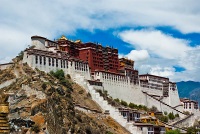
Potala Palace
The vast Potala Palace stands on a cliff top above Lhasa, considered the greatest achievement of Tibetan architecture. The palace was originally built in the 7th century by the the…
Potala Palace
The vast Potala Palace stands on a cliff top above Lhasa, considered the greatest achievement of Tibetan architecture. The palace was originally built in the 7th century by the then emperor for his bride. It was later partially destroyed by lightning and war, but restored and extended in 1645 by the Fifth Dalai Lama when he became the political and religious leader of Tibet. The Fifth Dalai Lama took up residence in the palace in 1653, and it remained the Dalai Lama's official residence until the exile of the 14th Dalai Lama in 1959.
The palace is renowned for its interior splendour. It consists of two main sections: the White Palace which is the secular section containing offices, dormitories, a Buddhist seminary and printing house; and the Red Palace, which is the sacred sanctuary dedicated to religious study and prayer. The latter contains chapels where the mummified remains of three Dalai Lamas lie, and the Great West Hall famous for its rich murals. The only remaining structures dating from the 7th century are the Dharma Cave and the Saint's Chapel, but the palace houses many ancient cultural treasures and relics. In fact, the palace contains over 10,000 shrines and 200,000 statues.
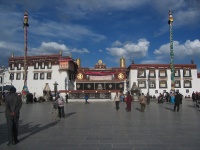
Jokhang Temple
The Jokhang Temple lies in the heart of Lhasa. It was built nearly 1,300 years ago but remains the spiritual centre of Tibet, drawing pilgrims from all over the region who come to …
Jokhang Temple
The Jokhang Temple lies in the heart of Lhasa. It was built nearly 1,300 years ago but remains the spiritual centre of Tibet, drawing pilgrims from all over the region who come to demonstrate piety to the Buddha. The original structure was enlarged under the reign of the Fifth Dalai Lama and it now stands as the product of Han, Tibetan and Nepalese architectural design. It is a four-storey timber temple with a golden roof that contains a number of valuable cultural relics, sacred sculptures and magnificent murals.
Possibly the most special statue is the site's original sculpture of Buddha called Jowo, which is richly decorated with jewels and silk. An annual prayer festival is held in the temple, which is also the venue for the initiation of the Dalai Lamas. The Jokhang Temple is a UNESCO World Heritage Site and it is generally considered to be Tibet's most sacred and important temple.
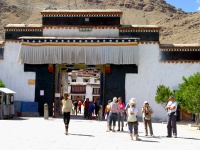
Tashi Lhunpo Monastery
Tashi Lhunpo is one of Tibet's most revered and influential monasteries, lying about a mile (2km) to the west of Shigatse at the base of Drolmari Mountain. Founded by the First Dal…
Tashi Lhunpo Monastery
Tashi Lhunpo is one of Tibet's most revered and influential monasteries, lying about a mile (2km) to the west of Shigatse at the base of Drolmari Mountain. Founded by the First Dalai Lama in 1477, it became the seat of Tibet's second most important spiritual leader, the Panchen Lama, in 1713. The monastery today houses about 800 monks in its 3,229 square foot (300 sq m) of muraled buildings.
The oldest section is the main chanting hall that houses the throne of the Panchen Lama. The tallest section is the Maitreya Chapel, which contains the world's largest brass statue of Maitreya. The seated figure is 86 feet (26m) high and decorated with gold, pearl, amber, copper, coral, diamonds and other precious stones. It's said that it took 900 craftsmen nine years to complete the statue.
There are other treasures such as the remarkable Thangka Wall, which is nine floors high and used to display massive images of Buddha on important days in the Tibetan Lunar Calendar.
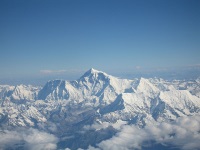
Mount Everest
The Shigatse prefecture is the gateway for climbers to the North Col route of the world's highest mountain. The ultimate climber's challenge, Mount Everest towers at 29,028 feet (8…
Mount Everest
The Shigatse prefecture is the gateway for climbers to the North Col route of the world's highest mountain. The ultimate climber's challenge, Mount Everest towers at 29,028 feet (8,848m) on the border between Tibet and Nepal. Access to the Everest Base Camp is via the town of Tinggri. About 20 miles (30km) from the town, climbers embark on a 48-mile (78km) trek to the first camp.
About six miles (10km) from the base camp is Rongbuk Monastery, the highest monastery on earth at an altitude of 16,728ft (5,099m). The monastery is continually being restored and offers hostel accommodation. Just south of the monastery is the world-renowned Rongbuk Glacier.
Because of its height, adventurers wishing to climb Mount Everest will need to allow several weeks simply to acclimatise to the thin atmosphere. Climbing Mount Everest is not to be attempted without the aid of a guide, and should only be tackled by extremely experienced climbers. Numerous travel agencies offer package multi-day hikes around the area and up to the Everest base camp.
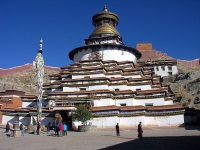
Pelkor Monastery
The fascinating Pelkor Monastery is situated at the foot of Dzong Hill in Tibet. Also called Baiju Monastery, it has an unusual structural style incorporating Han, Tibetan and Nepa…
Pelkor Monastery
The fascinating Pelkor Monastery is situated at the foot of Dzong Hill in Tibet. Also called Baiju Monastery, it has an unusual structural style incorporating Han, Tibetan and Nepali influences. The main structures were built around the beginning of the 15th century, and now house richly embroidered Tibetan opera costumes of pure silk dating to the Ming and Qing dynasties. It's unique in that it's the only monastery to accommodate monks from three different Buddhist orders. A popular pilgrimage site, it houses a number of shrines, frescoes and the renowned Arhat clay sculptures. But the most famous attraction at Pelkor Monastery is the Bodhi Dagoba, a building consisting of nine tiers, 108 gates and 76 shrines to Buddha.
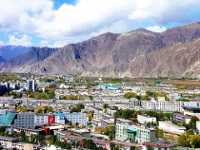
Lhasa
Lhasa is a holiday destination set in a marshy valley dominated by surrounding mountain peaks. It is the capital of the Tibet Autonomous Region and one of the highest cities in the…
Lhasa
Lhasa is a holiday destination set in a marshy valley dominated by surrounding mountain peaks. It is the capital of the Tibet Autonomous Region and one of the highest cities in the world at an elevation of 12,000ft (3,658m). Lhasa has long been the religious, cultural and political centre of Tibet, sheltered from the harsh winds of the Tibetan plateau in a spot that has been inhabited for at least 1,500 years.
Being the religious centre for Lamaist Buddhists since ancient times, flocks of pilgrims have made their way to Lhasa over the centuries to worship at the feet of the Dalai Lama. Now tourists on holiday are following in their wake to explore the surrounding mountains and investigate Tibet's unique culture and long history. While the city is currently enjoying a period of rapid modernisation, it retains its importance and aura as a holy city.



